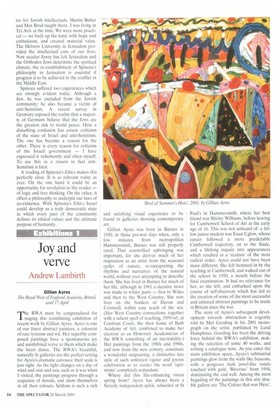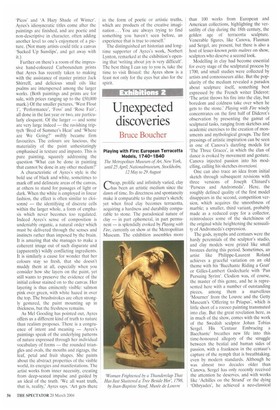Joy and verve
Andrew Lambirth
Gillian Ayres The Royal West of England Academy, Bristol, until 17 April
The RWA must be congratulated for staging this scintillating exhibition of recent work by Gillian Ayres. Ayres is one of our finest abstract painters, a colourist of rare lyricism and wit. Her superbly composed paintings have a spontaneous joy and uninhibited verve to them which make the heart dance. The RWA's beautiful, naturally lit galleries are the perfect setting for Ayres's dramatic canvases: their scale is just right. As the light changes on a day of wind and rain and sun, such as it was when I visited, the paintings progress through a sequence of moods, and show themselves in all their colours. Seldom is such a rich
and satisfying visual experience to be found in galleries showing contemporary art.
Gillian Ayres was born in Barnes in 1930, in those pre-war days when, only a few minutes from metropolitan Hammersmith, Barnes was still properly rural. That countrified upbringing was important, for she derives much of her inspiration as an artist from the seasonal cycles of nature, re-interpreting the rhythms and narratives of the natural world, without ever attempting to describe them. She has lived in Barnes for much of her life, although in 1981 a decisive move was made to wilder parts — first to Wales and then to the West Country. She now lives on the borders of Devon and Cornwall, within easy reach of the sea. (Her West Country connections, together with a salient spell of teaching, 1959-65, at Corsham Court, the then home of Bath Academy of Art, combined to make her election as an Honorary Academician of the RWA something of an inevitability.) Her paintings from the 1980s and 1990s, and now from the new century, constitute a wonderful outpouring, a distinctive late style of such unforced vigour and joyous celebration as to render the word 'optimistic' completely redundant.
Where did this life-enhancing vision spring from? Ayres has always been a fiercely independent spirit, schooled at St Paul's in Hammersmith, where her best friend was Shirley Williams. before leaving for Camberwell School of Art at the early age of 16. This was not unheard of: a fellow junior student was Euan Uglow, whose career followed a more predictable Camberwell trajectory, on to the Slade, and a lifelong inquiry into appearances which resulted in a 'realism' of the most radical order. Ayres could not have been more different. She felt hemmed in by the teaching at Camberwell, and walked out of the school in 1950, a month before the final examination. It had no relevance for her, so she left, and embarked upon the course of self-discovery which has led to the creation of some of the most successful and admired abstract paintings to be made in Britain since the war.
The story of Ayres's subsequent development towards abstraction is cogently told by Mel Gooding in his 2001 monograph on the artist, published by Lund Humphries. Gooding has been the driving force behind the RWA's exhibition, making the selection of some 40 works, and writing a catalogue note. As you enter the main exhibition space, Ayres's substantial paintings glow from the walls like beacons, with a gorgeous dark jewel-like tondo touched with gold, `Riverine' from 1994, dominating the end wall. Among the most beguiling of the paintings in this airy double gallery are 'The Colour that was Here', `Picos' and 'A Hazy Shade of Winter'. Ayres's idiosyncratic titles come after the paintings are finished, and are poetic and non-descriptive in character, often adding another level to one's enjoyment of a picture. (Not many artists could title a canvas 'Sucked Up Sunslips', and get away with it.) Further on there's a room of the impressive hand-coloured Carborundum prints that Ayres has recently taken to making with the assistance of master printer Jack Shirreff, and delicious small oils like psalms are interspersed among the larger works. (Both paintings and prints are for sale, with prices ranging up to the £50,000 mark.) Of the smaller pictures, 'West Float 1', 'Performance', 'Foss' and 'Rose Fair', all done in the last year or two, are particularly eloquent. Of the larger — and some are very large indeed — the ravishing triptych 'Bred of Summer's Heat' and 'Where are We Going?' swiftly became firm favourites. The colours are luscious, the materiality of the paint unhesitatingly emphasised in texture and impasto. This is pure painting, squarely addressing the question 'What can be done in painting that cannot be done in any other medium?'
A characteristic of Ayres's style is the bold use of black and white, sometimes to mark off and delineate areas of the canvas, at others to stand for passages of light or dark. When the white is employed in linear fashion, the effect is often similar to cloisonné — the identifying of discrete cells within the larger whole, a form of emphasis which never becomes too regulated. Indeed Ayres's sense of composition is undeniably organic, a natural order which must be delivered through the senses and instincts rather than imposed by the brain. It is amazing that she manages to make a coherent image out of such disparate and (apparently) wildly conflicting ingredients. It is similarly a cause for wonder that her colours stay so fresh, that she doesn't muddy them at all, especially when you consider how she layers on the paint, yet still wants to preserve the evidence of the initial colour stained on to the canvas. Her layering is thus eminently visible: salmon pink over green, with white hazed in over the top. The brushstrokes are often strongly gestured, the paint mounting up in thickness, but the freshness remains.
As Mel Gooding has pointed out, Ayres offers us a different kind of truth to nature than realism proposes. There is a congruence of intent and meaning — Ayres's paintings speak of the underlying patterns of nature expressed through her individual vocabulary of forms — the rounded triangles and ovals, the mouths and zigzags, the leaf, petal and fruit shapes. She paints about the abstract properties of the visible world, its energies and manifestations. The artist works from inner necessity, creating from deep-seated impulse and guided by an ideal of the truth. 'We all want truth, that is, reality,' Ayres says. 'Art gets there in the form of poetic or artistic truths, which are products of the creative imagination ... You are always trying to find something you haven't seen before, an experience that is true to oneself.'
The distinguished art historian and longtime supporter of Ayres's work, Norbert Lynton, remarked at the exhibition's opening that 'writing about joy is very difficult'. The best thing I can say to you is, take the time to visit Bristol: the Ayres show is a feast not only for the eyes but also for the spirit.



















































































 Previous page
Previous page